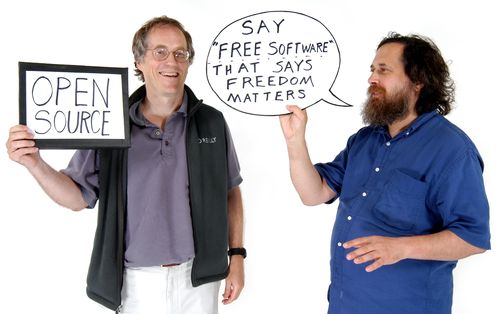You can visit the website created for Module 9: The economics of educational technology or you can stay right here and read two summaries authored by me.
Your comments are welcome and encouraged 🙂
A Summary of Some Simple Economics of Open Source by Josh Lerner and Jean Tirole
Josh Lerner and Jean Tirole, authors of Some Simple Economics of Open Source, wrote the article for The Journal of Industrial Economics in the summer of 2002. The article investigates the economics of open source software and the relation that open source software has to labour economies.
Lerner and Tirole (2002) define open source software as software that has been developed as a result of numerous organizations in different locations sharing code to develop and amend the software programs. Lerner and Tirole credit the flood of interest in open source to three factors:
- The increasing distribution of open source software in the global market
- The considerable and numerous capital investments made to open source projects by major corporations (Hewlett Packard, IBM, Sun, Linux, Cobalt Networks, Collab.Net, Scriptics, and Sendmail)
- The collaborative nature of open source ventures
Lerner and Tirole present four case studies on open source projects: Apache, Linux, Perl and Sendmail. The authors describe the key economic patterns that have resulted in the development of open source software and highlight the role of labour economics and industrial organization theory to explain the features of open source. Lerner and Tirole present the history of the open source movement, and briefly describe the first era (1960-1980), the second era (1980-1990) and the third era (1990 – today) of open source history.
The Economics of Open Source
Lerner and Tirole use economic theory to answer why people participate in open source, why open source projects exist, and to describe how commercial vendors have reacted to the evolution of open source.
The Opportunity Cost of Participating in Open Source Projects
Lerner and Tirole discuss the net benefit a programmer receives from participating in open source projects. The programmer weighs the opportunity cost of participating in said project and decides that the benefits outweigh the cost (cost/benefit analysis).
The authors suggest that the rewards for participation in an open source community are threefold:
- The career concern incentive: The career incentive refers to the future job opportunities, contacts, and professional relationships that a programmer may receive when participating in open source projects.
- The ego gratification incentive: The ego gratification incentive is accredited to the intrinsic motivation a programmer typically feels to solve complex problems and to prove their expertise in the field of computer science
- The signalling incentive: Lastly, the authors describe that the signalling incentive is related to the programmer’s desire to work on projects that are highly visible and respected within their professional community.
Comparing Open Source and Closed Source Programming Incentives
Lerner and Tirole suggest five features that differentiate open source and closed source programming environments and suggest that these features best describe who is most likely to contribute to an open source project as well as define the tasks best suited to open source.
- Alumni effect: The code is freely available and can be used in an educational setting which lowers to cost and increases to accessibility.
- Customization and bug-fixing benefits: The cost of contributing to an open source project is offset by the benefit of solving complex problems and of receiving gratification from within the open source community.
- Better performance measurement: The code of an open source project can be viewed by anyone, and improved by everyone.
- Full initiative: The open source programmer takes full responsibility for the work done and is self employed.
- Greater fluidity: An open source environment is more fluid, the authors argue because there is less bureaucracy to navigate through.
Commercial Vendors Reaction to Open Source
Commercial vendors have to protect the intellectual property rights of their programming code. To remain competitive Lerner and Tirole argue that the commercial entities must protect the identity of their employees and retain the legal rights to the code they produce. The nature of a commercial venture does not lend itself well to open source sharing and as the authors argue the collaborative aspects of open source production.
Lerner and Tirole contend that a commercial vendor may incorporate certain aspects of open source production into the development of the commercial code when it is advantageous to the commercial company, and when the commercial vendor is confident that there is an economic advantage to such collaboration.
Resource
Lerner, J. & Tirole, J. (2002). Some simple economics of open source. The Journal of Industrial Economics, 50(2), 197-234. Retrieved from http://www.jstor.org/stable/3569837
Images:
Free Open Source Softwares [Image file]. (n.d.). Retrieved July 4, 2012, from http://www.fluxfun.com/wp-content/uploads/2011/10/free-open-source-softwares-large.jpg
Paley, N. (2011). Exploitation [Image file]. Retrieved July 4, 2012, from http://mimiandeunice.com/2011/08/15/exploitation/
Richard Stallman and Tim O’Reilly in free software foundation and open source initiative [Image file]. (n.d.). Retrieved July 4, 2012, from open-source-vs-free-software-tim-oreilly-richard-stallman-485.jpg
Summary By: Tara Avenia
A Summary of the Economics of Educational Technology by Jeffrey M. Puryear
Jeffrey M. Puryear, the vice president for social policy at The Inter-American Dialogue (a centre for policy analysis, exchange and communication for the Western world), former head of the Ford’s Foundation, and research scholar at New York University wrote the article, The Economics of Educational Technology in the fall of 1999. Puryear has a PhD in comparative education, and is an established author (Inter-American Dialogue, 2007, Staff section). In his article, Puryear assesses educational technologies based on three economic conditions: cost, effectiveness, and the surrounding conditions. He argues that the blackboard and chalk are among the best examples of an economic educational technology.
Puryear (1999) argues the blackboard and chalk are cost effective because they are inexpensive to produce, easily transported, and readily available. The blackboard and chalk are effective because they can be mastered by any person who possess basic literacy skills and can be used to educate students of all ages (elementary through post secondary). The blackboard and chalk require little to no maintenance, and can be used to maximize learning without pulling any resources from the surrounding environment. The blackboard and chalk, Puryear decides, are a sound economic investment because they will maximize the output (the learning) and require the least amount of inputs to produce. Puryear concludes the article by warning the reader that the biggest obstacle in adopting an educational technology is in obtaining the political and institutional support necessary to successful implement said technology. He reminds the reader that technology and economics are not the ends but only a means to produce a more effective and efficient product.
Cost
Fixed Cost
As Puryear (1999) describes when evaluating the cost of a technology, you must consider both the fixed costs and variable costs. A fixed cost is the cost of production. They are often an upfront investment that you will pay to manufacture the technology. In technology production, the fixed cost may be a combination of the managerial fees, the hardware, and the cost of the software. The fixed costs are divided among the customers. In educational technology, the total fixed costs are divided among the students to determine the fixed cost per student.
Variable Cost
Puryear (1999) defines the variable cost as the cost that is added once the technology has been produced. A variable cost of technology may be the cost to train teachers to use the technology, the cost of maintenance, support, the additional cost of electricity and the cost of internet connectivity if applicable.
Effectiveness
Economics is concerned with the way resources are used to achieve a goal. To be effective, you will use the desired resources to achieve the end goal. To be efficient, you will use the least amount of resources to achieve the desired goal. An economist will remind you that our wishes are endless, but our resources are finite.
Puryear (1999) suggests that in evaluating an educational technology, one should assess whether the technology is effective (does it reach its goal) and if so, why is the technology effective. He recommends that we assess the cost effectiveness of said technology by evaluating if the technology is both effective and efficient.
Surrounding Conditions
When assessing an educational technology, Puryear (1999) recommends that we assess the conditions that are necessary for the technology to operate successfully. An economist would call this the production possibilities schedule. The production possibilities schedule determines the number of outputs that will be produced with each specific number of inputs. When assessing the technology you must measure what combinations of inputs are needed to maximize the output. You must determine how to use your resources, (the inputs) in the most effective and efficient way. In educational technology we are concerned with what we must invest to maximize the learning potential of our students.
Resources:
Puryear, J. M. (1999, September). The economics of educational technology. TechKnowLogia, 46-49. Retrieved from http://www.techknowlogia.org/TKL_Articles/PDF/17.pdf
Inter-American Dialogue. (2007). Retrieved July 4, 2012, from the Inter-American Dialogue website: http://www.thedialogue.org/staff
Images:
Avenia, T. (Artist). (2012) Reliable, dependable and affordable technology: Looking for work [Image file].
Glasbergen, R. (Artist). (n.d.) edu07: There aren’t any icons to click. It’s a chalk board [Image file]. Retrieved July 4, 2012, from http://www.glasbergen.com/education-cartoons/?album=4&gallery=85
Glasbergen, R. (Artist). (n.d.) edu17: Download answer … estimated time remaining 04:14 [Image file]. Retrieved July 4, 2012, from http://www.glasbergen.com/education-cartoons/?album=4&gallery=85
Summary By: Tara Avenia





